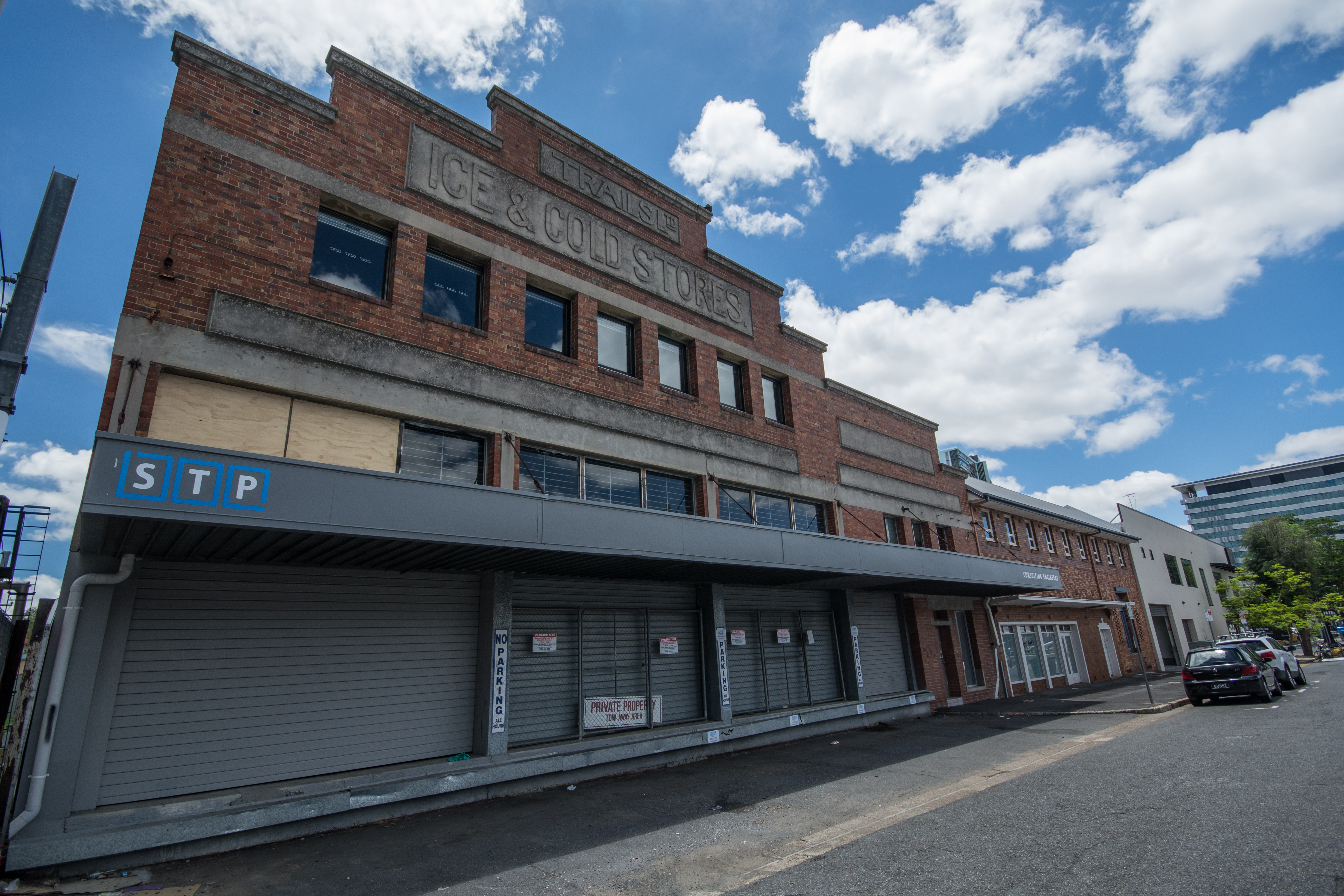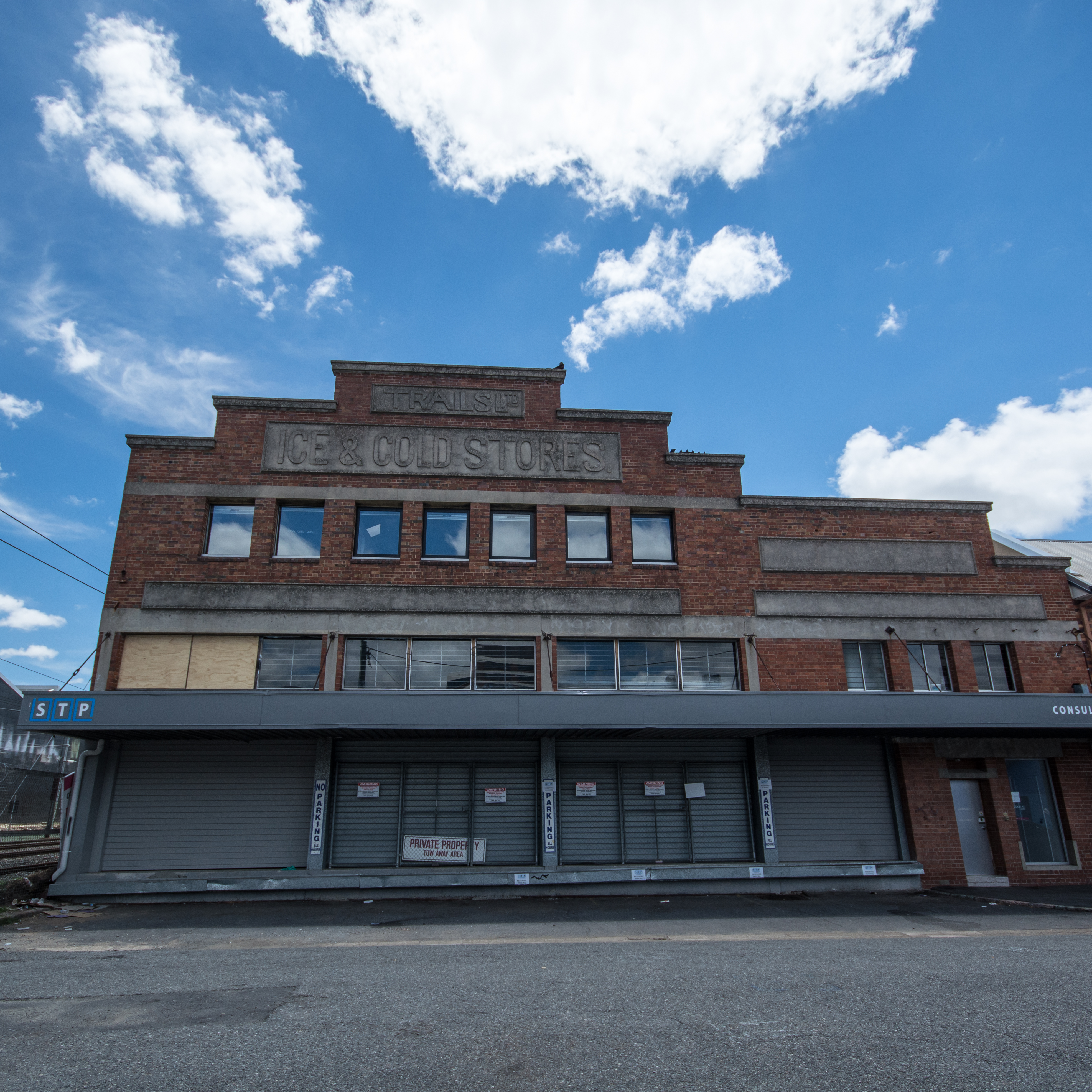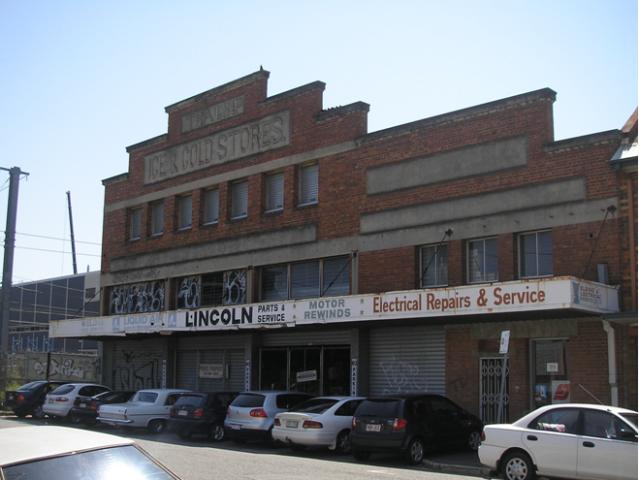Addresses
Type of place
Warehouse, Factory
Period
Interwar 1919-1939
Style
Free Style
Addresses
Type of place
Warehouse, Factory
Period
Interwar 1919-1939
Style
Free Style
The Trails Ltd building on Bridge Street is a fine example of interwar industrial growth in the Fortitude Valley area. Built in 1936 and designed by eminent Brisbane architect R. M. Wilson, the substantial brick building is representative of the ice manufacturing and cold storage industry prior to the introduction of small scale, domestic refrigeration. Easily seen by passing railway traffic, the Trails Ltd building is a Fortitude Valley landmark.
Lot plan
L2_RP196276
Key dates
Local Heritage Place Since —
Date of Citation —
Construction
Walls: Face brickPeople/associations
Ronald Martin Wilson (Architect)Criterion for listing
(A) Historical; (B) Rarity; (E) AestheticInteractive mapping
Lot plan
L2_RP196276
Key dates
Local Heritage Place Since —
Date of Citation —
Construction
Walls: Face brickPeople/associations
Ronald Martin Wilson (Architect)Criterion for listing
(A) Historical; (B) Rarity; (E) AestheticInteractive mapping
History
Built in 1936 the Trails Ltd building on Bridge Street, Fortitude Valley demonstrates the industrial nature of this area in this period. The substantial brick warehouse, with decorative front parapet displaying the company’s logo, “Trails Ltd, Ice and Cold Stores” was designed by respected Brisbane architect, R. M. Wilson, and is a landmark in this area of Fortitude Valley.
The First sale of land in Fortitude Valley occurred in 1844. Nine suburban allotments of two and four acres each were offered at an upset price of £3 per acre. However the land at Kangaroo Point and in the centre of the settlement at north Brisbane was more sought after and when in 1846 the town limits of Brisbane were proclaimed, Fortitude Valley fell outside the limit.
By 1854 there were about 150 dwellings in the Fortitude Valley area, stretching as far as Breakfast Creek. In 1858 Wickham Street was surveyed from the corner of Ann Street to Boundary Street. At this stage very few commercial premises had been erected, and Valley residents relied on North Brisbane traders for supplies. Despite these difficulties the population was steadily growing. A government census in 1861 showed that there was a total population of over 1300 people in Fortitude Valley by that year.
The densely packed houses of working men and women were predominant in the Valley. To cater for the influx of working class families, new housing was built on tiny allotments in narrow streets, where speculators had divided estates into the maximum possible number of blocks of land. Tiny cottages sprang up in the streets beyond the Valley’s commercial centre. It was this type of subdivision which prompted the government in 1885 to pass the Undue Subdivision of Land Prevention Act which prohibited the subdivision of allotments smaller than 16 perches.
In 1884 construction began on a double line of tram tracks through the Valley to Breakfast Creek. The tramway was opened the following year, and a depot and stables were built in Light Street (the site of the present bus depot). The availability of public transport helped to consolidate the Valley’s residential settlement.
Within a very short time span the residential nature of the Valley began to be eroded. As the 1890s progressed those residential sections in close proximity to the rapidly growing retail and industrial areas were changing. The Valley became a heterogeneous area, and it was not uncommon for houses to have motor garages, factories, churches and even hotels as neighbours. Throughout the 1890s large factories and warehouses were established beyond the retail centre, close to the workers’ dwellings.
The residential nature of the Valley further shifted through the 1910s and 20s. As public transport to the middle suburbs improved, families began moving away from the crowded inner suburbs. Many homes in the Valley heart that had once housed single families were converted to boarding houses, a use that continued for most of the century.
The area prior to the early 1930s was primarily residential. In 1936 Trails Ltd purchased the Bridge Street property. The company was a well-established one dating back to the turn of the twentieth century, with an ice and storage works operating on the river at Newstead Wharf. The Brisbane City Council Minutes from 1936 state the land on which the works had originally operated had been dispossessed and the works were to be relocated to the Bridge Street site. Concerns were expressed as to the increased level of noise the ice works would generate at all hours. These concerns were abated with the acknowledgement of the shift that had occurred in this area of Fortitude Valley in the recent years, from residential to industrial; the proposed location would indeed be suitable.
In 1936 the plans were approved for the construction of the ice works and would cost ₤7500. The builder was A. Lind of New Farm. The substantial brick structure was designed by R. M. Wilson, the highly regarded Brisbane architect. His plans were entitled “Trails Ltd., Proposed Freezing, Ice Making and Cold Storage Works”, and included specifications including an attic, a store, and effective insulation systems.
Ronald Martin Wilson was a Brisbane born architect and son of eminent Federation period architect A. B. Wilson. Ronald became chief architectural assistant at his father’s firm in 1908 after completing his tertiary education studying Engineering at the University of Queensland. After working for the British Ministry of Munitions during the First World War, he studied Town Planning in London and returned to Brisbane in 1919. He established a firm with his father in 1920 and continued the business subsequent to his father’s retirement in 1928. His work includes the Cliffside Flats at Kangaroo Point, Birt & Co. Wharves at Newstead, and the St. Lucia and Ithaca Presbyterian Churches.
Trails Ltd provided an important service in Brisbane during the 1930s, 40s and 50s. This was a time when refrigeration facilities for both commercial and domestic spheres relied on the delivery of large blocks of ice for the safe storage of food stuffs. The advent of the electric refrigerator and its popular use in households only occurred in the 1950s as the technology became affordable. The large scale manufacture of ice and the need for cold storage facilities for the food industry created a reliance on ice and cold storage works such as Trails Ltd. The area of Newstead, Teneriffe and Fortitude Valley was particularly noted for industry which dealt with primary produce, Trails Ltd. is an example of the subsidiary industry that supported commerce in this area.
The Trails Ltd building provides an excellent example of the development of industry in Brisbane. The substantial brick building demonstrates the importance placed in the aesthetics of building design during this period, regardless of use.
Description
This two-storey brick, former industrial building has a large gable roof clad with corrugated metal sheets. The decorative front has a stepped parapet with the company logo, ‘Trails Ltd. Ice & Cold Stores’ in cement render. There is a series of small windows under the logo in the first floor, and an original top hung awning spanning the width of the building which shelters the original loading bays.
Statement of significance
Relevant assessment criteria
This is a place of local heritage significance and meets one or more of the local heritage criteria under the Heritage planning scheme policy of the Brisbane City Plan 2014. It is significant because:
References
-
Brisbane City Council Minutes, July 1936-June 1937
-
Historic Titles, Department of Natural Resources and Water
-
Queensland Post Office Directories
-
Watson, Donald & Judith McKay 1994, Queensland Architects of the 19th Century, University of Queensland Press, St. Lucia
-
Detail Fire Survey: City of Brisbane, 1951, Mahlstedt’s: Consulting Fire Engineers and Surveyors, Melbourne
-
North Brisbane Electoral Rolls, 1898 and 1900
-
Watson, Donald and McKay, Judith. Queensland Architects of the Nineteenth Century: A Biographical Dictionary. Brisbane: Queensland Museum, 1995
Citation prepared by — Brisbane City Council (page revised September 2021)




